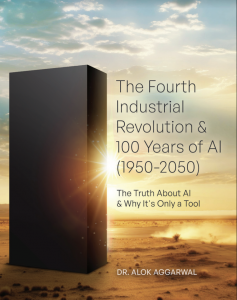
The Fourth Industrial Revolution & 100 Years of AI explores how Artificial Intelligence will impact our society during the coming decades
SAN JOSE, CALIFORNIA, USA, March 21, 2024 /EINPresswire.com/ — Alok Aggarwal’s new book, “The Fourth Industrial Revolution & 100 Years of AI (1950-2050),” offers a thought-provoking glimpse into the current state and future possibilities of AI, emphasizing the need to address its limitations for responsible and impactful integration into our society. The eleventh chapter – titled “Limitations of Contemporary AI Systems and Their Consequences”- explores how although Generative AI (Gen-AI) systems are the rage today, they are beset with confounding limitations.
This chapter provides the following take-aways:
• Limitations of AI systems from 1970s still exist: Most AI systems suffer from the following debilitating limitations – (a) they need enormous data even for simple classifications, (b) they usually need to learn from scratch even though they have just learnt something similar, (c) since we do not know how humans really think, it is hard to train AI systems in the same way as we train humans, (d) most AI systems are now so complex that we do not understand how they work, and (e) improving their accuracy comes at an exorbitant price relate to the use of human labor, electricity, as well as computational and memory resources.
• Additional limitations of Generative Pretrained Transformers (GPTs) and Large Language Models (LLMs): Although some AI professionals called Transformers as “foundation models”, they suffer from the same debilitating limitations as other Deep Learning Networks mentioned above. In addition, they have the following disadvantages – (a) since they are trained on less than 0.001% of all Internet data, their answers to questions that are in narrow field, are often incorrect, but they still give them with very high confidence, (b) they lack subject matter expertise, (c) they cannot provide qualitative judgment, and (d) they are limited about the size of input and output.
• Contemporary AI systems (including GPTs and LLMs) are brittle and sometimes hallucinate: DLNs are brittle and often falter even with small perturbations. Even when they falter, they do so with utmost confidence, and they often seem to make up strange answers, thereby exhibiting “Machine Hallucinations” that are like those exhibited by humans.
• Machine Endearment and malware injections: Since they are trained on vast troves of human-written data, they usually produce outputs that also appear quite convincingly human. Undoubtedly, the output from most GPTs and LLMs is confident, syntactically coherent, polite, and eloquent, which makes them appear endearing – and even sentient – to many humans. Chapter 11 provides several examples where the combination of Machine Hallucinations and Machine Endearment have even tripped lawyers and other knowledgeable professionals into making massive blunders.
• It is much easier to infuse GPTs and LLMs with malware (called “Prompt Injections”), which could cause havoc for the users.
• Important consequences of the above-mentioned limitations that could harm human society; These include – (a) DLNs often use data for training that is copyrighted and there doesn’t seems to be suitable mechanism to compensate the data-owner, (b) Machine Hallucinations often lead to fake content, which can be used for training other DLNs, thereby reinforcing it for humans and AI systems, (c) Machine Endearment may lead some humans to believe that these AI systems are sentient and trustworthy, which in turn may them believing in extreme ideologies, being swindled, allowing their identities to be stolen, and buying things or services they do not need, and (d) potentially being infused with Prompt Injections that can be catastrophic for the users and human society.
• Current hype versus reality in AI: The current hype in AI is reminiscent of the boom phase between 1956 and 1973 (see chapter 2) but that euphoria was short-lived. Because DLNs falter easily, the current hype regarding GPTs and LLMs may also be short lived.
Overall, “The Fourth Industrial Revolution & 100 Years of AI (1950-2050)” provides a concise yet comprehensive exploration of AI, covering its origins, evolutionary trajectory, and its potential ubiquity during the next 26 years. Beginning with an introduction to the fundamental concepts of AI, subsequent chapters delve into its transformative journey with an in-depth analysis of achievements of AI, with a special focus on the potential for job loss and gain. The latter portions of the book examine the limitations of AI, the pivotal role of data in enabling accurate AI systems, and the concept of “good” AI systems. It concludes by contemplating the future of AI, addressing the limitations of classical computing, and exploring alternative technologies (such as Quantum. Photonics, Graphene, and Neuromorphic computing) for ongoing advancements in the field. This book is now available in bookstores and online retailers in Kindle, paperback, and hard cover formats.
About the Author: Dr. Aggarwal is the founder, CEO, and Chief Data Scientist of Scry AI, which provides innovative AI-based products, solutions, and services to enterprises across the globe. Before starting Scry AI, he co-founded Evalueserve (www.evalueserve.com) which provides research and analytics services worldwide. He received his Ph. D. from Johns Hopkins University and worked at IBM’s T. J. Watson Research Center during 1984 and 2000. He has written more than 120 research articles and has been granted eight patents. For more information, please visit: www.scryai.com
Alok Aggarwal
Scry AI, Inc.
+1 9149804717
email us here
Visit us on social media:
Facebook
Twitter
LinkedIn
Instagram
YouTube
![]()
Originally published at https://www.einpresswire.com/article/696943371/limitations-of-contemporary-ai-systems-and-their-consequences-explored-in-new-book-by-alok-aggarwal



